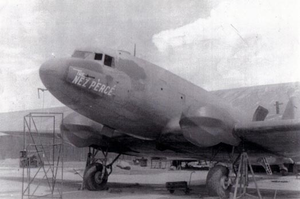
The Douglas DC-3 is a propeller-driven airliner manufactured by Douglas Aircraft Company, which had a lasting effect on the airline industry in the 1930s to 1940s and World War II. It was developed as a larger, improved 14-bed sleeper version of the Douglas DC-2. It is a low-wing metal monoplane with conventional landing gear, powered by two radial piston engines of 1,000–1,200 hp (750–890 kW). Although the DC-3s originally built for civil service had the Wright R-1820 Cyclone, later civilian DC-3s used the Pratt & Whitney R-1830 Twin Wasp engine. The DC-3 has a cruising speed of 207 mph (333 km/h), a capacity of 21 to 32 passengers or 6,000 lbs (2,700 kg) of cargo, and a range of 1,500 mi (2,400 km), and can operate from short runways.

The McDonnell XF-88 Voodoo was a long-range, twinjet fighter aircraft with swept wings designed for the United States Air Force. Although it never entered production, its design was adapted for the subsequent supersonic F-101 Voodoo.

The Douglas C-47 Skytrain or Dakota is a military transport aircraft developed from the civilian Douglas DC-3 airliner. It was used extensively by the Allies during World War II. During the war the C-47 was used for troop transport, cargo, paratrooper, for towing gliders and military cargo parachute drops. The C-47 remained in front-line service with various military operators for many years. It was produced in approximately triple the numbers as the larger, much heavier payload Curtiss C-46 Commando, which filled a similar role for the U.S. military.

The Douglas C-54 Skymaster is a four-engined transport aircraft used by the United States Army Air Forces in World War II and the Korean War. Like the Douglas C-47 Skytrain derived from the DC-3, the C-54 Skymaster was derived from a civilian airliner, the Douglas DC-4. Besides transport of cargo, the C-54 also carried presidents, prime ministers, and military staff. Dozens of variants of the C-54 were employed in a wide variety of non-combat roles such as air-sea rescue, scientific and military research, and missile tracking and recovery. During the Berlin Airlift it hauled coal and food supplies to West Berlin. After the Korean War it continued to be used for military and civilian uses by more than 30 countries. It was one of the first aircraft to carry the President of the United States, the first being President Franklin D. Roosevelt during World War II.

The Douglas DC-4 is an American four-engined (piston), propeller-driven airliner developed by the Douglas Aircraft Company. Military versions of the plane, the C-54 and R5D, served during World War II, in the Berlin Airlift and into the 1960s. From 1945, many civil airlines operated the DC-4 worldwide.

The Douglas XB-42 Mixmaster was an experimental American bomber aircraft, designed for a high top speed. The unconventional approach was to mount the two engines within the fuselage driving a pair of contra-rotating propellers mounted at the tail in a pusher configuration, leaving the wing and fuselage clean and free of drag-inducing protrusions.
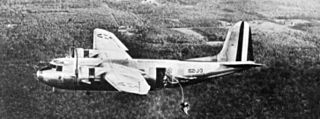
The Douglas DC-5 was a 16-to-22-seat, twin-engine propeller aircraft intended for shorter routes than the Douglas DC-3 or Douglas DC-4. By the time it entered commercial service in 1940, many airlines were canceling orders for aircraft. Consequently, only five civilian DC-5s were built. With the Douglas Aircraft Company already converting to World War II military production, the DC-5 was soon overtaken by world events, although a limited number of military variants were produced.
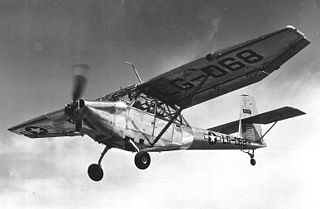
The Stinson L-13 was a US military utility aircraft first flown in 1945.

The Douglas C-74 Globemaster was a United States heavy-lift cargo aircraft built by the Douglas Aircraft Company in Long Beach, California. The aircraft was developed after the Japanese attack on Pearl Harbor. The long distances across the Atlantic and, especially, Pacific oceans to combat areas indicated a need for a transoceanic heavy-lift military transport aircraft. Douglas Aircraft Company responded in 1942 with a giant four-engined design. Development and production modifications issues with the aircraft caused the first flight to be delayed until 5 September 1945, and production was limited to 14 aircraft when the production contract was canceled following V-J Day.

The Douglas O-46 was an observation aircraft used by the United States Army Air Corps and the Philippine Army Air Corps. It entered service in the late 1930s, and saw action in WW2;it became obsolescent later in the war as an observation craft, but was used for liaison, training, and ASW patrols. One airframe survived as a museum piece into the present day.
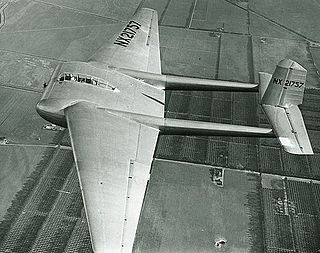
The XCG-16 was a military transport/assault glider ordered by the United States Army Air Forces (USAAF), from General Airborne Transport Co., for competition against the Waco CG-13A at Wright Field. The XCG-16’s preferred tow aircraft was the Lockheed Model 18 Lodestar.

The Waco CG-4 was the most widely used American troop/cargo military glider of World War II. It was designated the CG-4A by the United States Army Air Forces, and given the service name Hadrian by the British.

The Chase XCG-18A and YC-122 Avitruc was a military transport aircraft designed by Chase Aircraft and produced in limited numbers in the United States in the late 1940s, initially as a glider, but definitively in powered form. The design was based on the CG-14 cargo glider but was substantially larger and featured all-metal construction. It was a high-wing cantilever monoplane. The fuselage was of rectangular cross-section and featured a loading ramp at its rear. The main undercarriage units were carried at the sides of the fuselage and were fixed, while the nosewheel was retractable. In its powered form, two radial engines were fitted in nacelles in the wings.
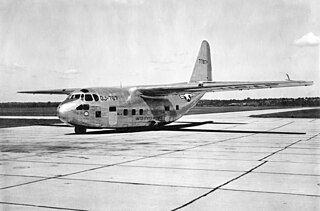
The Chase XCG-20, also known as the XG-20 and by the company designation MS-8 Avitruc, was a large assault glider developed immediately after World War II by the Chase Aircraft Company for the United States Air Force, and was the largest glider ever built in the United States. The XG-20 did not see production due to a change in USAF requirements, however, it was modified into the successful Fairchild C-123 Provider twin-engined transport aircraft which saw extensive service in the Vietnam War.

The Cornelius XFG-1 was an American military fuel transporting towed glider, without a tailplane and with a forward-swept wing. Two were built but development ended in 1945.
The St. Louis CG-5 was a 1940s American prototype military transport glider designed and built by the St. Louis Aircraft Corporation.
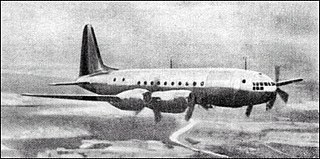
The Ilyushin Il-18 was a Soviet four-engined airliner designed and built by Ilyushin immediately after World War II. Although the aircraft itself was successful, its Shvetsov ASh-73TK engines were too unreliable for civilian use and were further needed to equip the Tupolev Tu-4 bomber, so it was cancelled in 1948.

The Chase XC-123A was an experimental transport aircraft developed by Chase Aircraft. The first jet-powered transport built for the United States Air Force, it was intended for use as a high-speed transport for high-priority cargo and personnel. The XC-123A was determined to have insufficient advantages over existing types in service, and did not go into production. The sole prototype was converted into the piston-powered Stroukoff YC-123D to evaluate boundary layer control systems.

The Douglas R4D-8 is a military transport aircraft developed from the civilian Douglas DC-3S airliner. It was used by the United States Navy and United States Marine Corps during the Korean War and Vietnam War.


